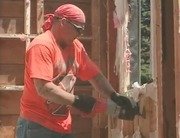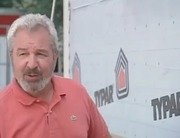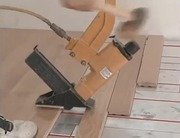Hi, I'm Bob Vila.
I have spent my whole career helping people upgrade their homes, and improve their lives.
Today with our planet in peril from global warming, resource depletion and pollution.
Nothing is more important than going green.
And when it comes to going green, your home is the place where you can make the the biggest difference.
The good news is that it doesn't have to cost you more.
Actually, going green can save you money while saving the plant.
All right this is beautiful.
In my new series Bob Vila, building green.
I'll demystify green home design and construction.
In each 30 minute episode, I'll take you to 3 green projects that are embracing, the cleanest and most efficient technologies, and I will give you all the information you'll need to make the right choices for your green project.
This is actually what we saw on the roof.
New York City is full of stunning architecture.
It's a testament to American ingenuity.
It's also home to some of the most energy -inefficient buildings on the planet.
This has got to change.
And that's exactly what's happening just a few miles north of here.
The south Bronx neighborhood of Hunts Point is known for high crime rates, urban decay, and some of the worst air quality in the country.
But Habitat for Humanity and developer Les Bluestone are trying to turn things around .
Making one building here a green oasis for low-income families.
So, Les, building green means different things to different people.
But you're a builder developer.
We 're in the heart of the south Bronx.
What is it about this 50-unit building you're completing that qualifies as green.
Well, we focus on energy efficiency.
We focus on indoor air-quality, a healthy building.
And we focus on sustainability, making as little impact onto the neighborhood and the planet as we can.
So.
Where do we get started?
What do we look at first?
Well let's start in the mechanical room where it all has happened.
Great.
Wow, this looks pretty traditional, nice work!
Thanks.
What do we have here?
Bob, what we have here is anything but traditional.
These are micro chp units.
What's chp?
Stands for combined heat and power.
Okay.
What they are, are electric generators, that run off of natural gas, the same gases that you turn out of the flame on the , you know.
So too many generators here that create electricity, which is used for what.
It's used to power the lighting in the building, used to power the pumps on the motors.
But what's interesting and what's green about this, is that the waste energy in terms of heat that would normally go up a vent pipe is being recaptured and used to heat all of the hot water for the entire building.
That's pretty amazing.
Can we see one of the apartments?
Sure.
So Les, this is a three-bedroom apartment?
Yeah, Bob, this is our three-bedroom apartment.
So, what's the square footage?
Ah about 1200 square-feet.
Nice.
Now, what are some of the important considerations that have gone into the space in terms of making it a healthy home.
Well, there are a number of things.
One, for us, it starts off with a tight shell.
So we try and make the building as tight as possible, so that we don't allow for air infiltration, and moisture, and potential for mold growth.
Mm-hm.
But now that we're building a tight shell, we have to guarantee that the indoor environment is healthy.
We do that in a number of ways.
One is, all of the paints, all of the finishes are all low or zero VOC, meaning that they don't emit volatile organic compounds.
Right.
We use recycled materials where ever possible; just on the sustainable side.
The dry wall?
The dry wall is 100 percent recycled.
A tight, green building means clean air.
Recycled materials mean less waste.
And energy efficient appliances like the ones they're installing in the habitat project, mean big savings.
But perhaps the greatest challenge facing any building, especially one in the city, is staying warm in the winter and cool in the summer.
And Les has come up with a very green solution.
Now what are the benefits of having a green roof like this.
The benefits are many.
One is that it limits the amount of run-off, storm water run-off.
So we don't end up dumping more run-off into the ocean; these plants will absorb that.
It provides insulation for the roof.
Mm-hm.
So that people who are in the building will not need to spend as much energy to heat or cool the building.
Yeah.
It also lowers the temperature of the roof itself.
Which eliminates the heat-island effect that's very common in urban areas.
Sure.
Now, in many parts of the country you're seeing builders and developers use reflective materials for roofing.
Again, from the perspective of how much energy it takes to air condition them etc.
In Florida and in Texas, they're putting up.
Cement tile rooms.
Are you doing anything like that here?
Yes, we actually have an upper roof where we're putting on a white coating today.
So there's a whole other section of the building that we can look at?
Yeah we can go up and take a look.
Let's go.
Bob, I want to introduce you to Josh Lockwood, the Executive Director of Habitat For Humanity NYC.
Hi Josh.
Hi Bob, how are you?
Excellent.
So, Habitat has had a unique role in this project, right?
We have.
This is the first time that Habitat for Humanity Nationwide has partnered with a private developer on a big multi- family building like this.
So we have volunteers coming in , thousands of them to build out twelve of the fifty units in this building.
And these guys that are making it a white roof, are they volunteers as well?
They are.
We have volunteers out today building out this white roof for us, and it's part of the energy efficient goals of this building.
Exactly.
Now, from the point of view of their individual goals.
They're building up credit in the bank, right?
In terms of the habitat program.
How does that work?
They are.
The family partner home buyers who were live in this building have to put in 300 hours a piece.
But then building along side them are just good-hearted, big-hearted folks who want to come out and do some good in the world.
That's great.
And then the white coating is a white paint of some sort.
What you're looking at is an Elastomeric coating --
Mm-hm.
-- that has two purposes.
One is to protect the membrane, to protect the roof.
More importantly is to reflect the sun.
And that lowers the temperature of the roof, and reduces the urban heat island effect that we have spoken of.
So in the summer months your air-conditioning bills are going to be lower as a result of this white.
Now, one of the interesting things here, though, is that we're in the south Bronx.
We're in a community where people normally can't afford green housing, or even new housing.
And very often are stuck in housing that's less than healthy.
We prioritize taking families who are living over-crowded buildings, dilapidated buildings.
Unaffordable building and moving them into healthier environments.
And Les has been a key partner in that effort.
Yeah, it's a great collaboration between Habitat and the private developer right?
Yes, it's very important for us to know that we can provide not only an energy efficient building will save them money, but also a healthy one.
And, to the people who most need it and can least afford it.
Excellent partnership, congratulations.
Thank you Bob.
Thank you Bob.
It's great.
Habitat for Humanity built their green project from the ground up.
Whether you're building from the ground up or simply remodeling, renovating, restoring , all are great opportunities to building green.




